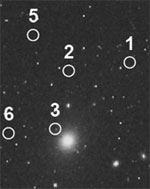
Image credit: Steve Phillipps
A new survey made with the Anglo-Australian Telescope (AAT) has revealed dozens of previously unsuspected miniature galaxies in the nearby Fornax galaxy cluster. They belong to a class of galaxies dubbed “ultra-compact dwarfs” (UCDs), which was unknown before the same team of astronomers discovered 6 of them in the Fornax cluster in 2000. Now they say the UCDs outnumber the “conventional” elliptical and spiral galaxies in the central region of the Fornax cluster and they have found some in the Virgo galaxy cluster too. It is possible that at least some are left-over examples of the primordial “building blocks” that formed large galaxies by merging together. It is likely that they are very common but have been overlooked because they resemble nearby stars at first sight. These results will be presented to the RAS National Astronomy Meeting at the Open University on Thursday 1 April by Dr Steven Phillips of Bristol University.
UCDs were discovered by chance when Dr Phillipps and his colleagues undertook a large survey of all the moderately bright objects they could see in the direction of the Fornax cluster. Only because they used a spectrograph (the Two Degree Field, or 2dF, system on the AAT) were they able to measure redshifts, which told them that 6 objects looking like local stars in our Galaxy were in fact in the Fornax cluster about 60 million light years away. Follow-up observations with the Hubble space Telescope and the European Southern Obervatory’s Very Large Telescope (VLT) revealed just how strange they are. Although their masses are similar to those of previously known dwarf galaxies, they are amazingly small – only about 120 light years across. Tens of millions of stars are squashed into what is a tiny volume by galaxy standards.
Favouring the idea that UCDs are the nuclei of galaxies that were originally larger and have been stripped of their outer stars, the team predicted that they would find them in other dense clusters where the stripping or ‘threshing’ process could go on. They also calculated how many more they would expect to find if they searched for fainter ones.
When they put their predictions to the test, 3 nights of observations uncovered a further 46 UCDs in Fornax – even more than the team had expected – and in just 4 hours they found 8 in the Virgo cluster, also around 60 million light years away. “These results indicate that UCDs are indeed common,” says Steve Phillipps, “and part of the standard population of galaxies we can expect in rich galaxy clusters. Given that we found so many, it is even possible that a proportion of them are the remnants of a population of primordial galaxies, remnants of the original building blocks of the large galaxies we find at the centres of clusters.”
Original Source: RAS News Release
